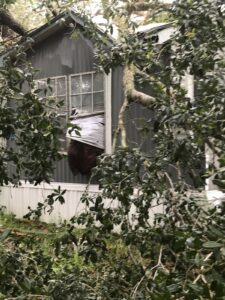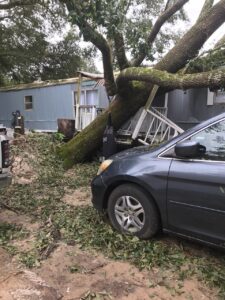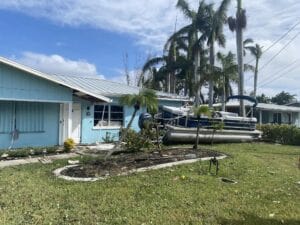Did you know that mobile homes are especially vulnerable to hurricane damage? When a storm strikes, these structures can be easily lifted or shifted, putting the safety of residents and their property at risk. That’s where mobile home tie-downs come in. These essential anchoring systems prevent your manufactured home from becoming a casualty of extreme weather conditions.
Secure Your Mobile Home with Hurricane Tie-Downs
Mobile home tie-downs not only protect against potential devastation but also ensure compliance with building code requirements. By following proper installation guidelines for tie downs, you can meet the necessary safety standards and provide a secure living environment.

Without reliable tie-down engineering, your roof could be blown off or your entire home might topple over during high winds. Don’t leave it up to chance; invest in top-quality mobile home hurricane straps to safeguard your valuable investment.
Remember, tying it down is not just an option – it’s a necessity!
Purpose and Installation Process of Hurricane Anchors
Hurricane anchors play a crucial role in securing mobile homes during severe weather conditions like hurricanes. These robust devices are designed to distribute forces evenly, preventing structural failure and minimizing the risk of damage.
Securing Mobile Homes to the Ground
When a hurricane strikes, strong winds can exert tremendous pressure on a mobile home, potentially causing it to shift or even become airborne. This is where hurricane anchors come into play. By firmly connecting the mobile home to the ground, these anchors provide stability and resistance against powerful gusts. They act as a safeguard, ensuring that your valuable investment remains intact during extreme weather events.
Even Force Distribution
One key advantage of hurricane anchors is their ability to distribute forces evenly throughout the structure. Rather than concentrating stress on specific points, these anchors disperse the load across multiple attachment points along the frame of the mobile home. This helps prevent any single area from bearing excessive strain, reducing the likelihood of structural failure or collapse.
Installation Process: Secure Your Mobile Home with Hurricane Tie-Downs
Installing hurricane anchors involves several steps that must be followed meticulously to ensure their effectiveness:
Assessing Soil Conditions: Before beginning installation, it is important to evaluate soil conditions at your location. Different types of soil may require specific anchoring techniques for optimal performance.
Attaching Anchors to Frame: The first step is attaching the hurricane anchors securely to the frame of your mobile home. Typically made from galvanized steel or other durable materials, these anchors are affixed at designated points along the perimeter.
Securing Anchors in Soil: Once attached to the frame, each anchor needs to be driven securely into the ground until it reaches an appropriate depth based on local building codes and manufacturer guidelines.
Tensioning Anchors: After securing all anchors in the soil, it is crucial to tension them properly. This involves tightening the anchor straps or cables to create sufficient resistance against lateral forces.
Read more on our articles: Mobile Home Anchors
Professional Installation for Optimal Effectiveness
While it is possible to install hurricane anchors yourself, professional installation is highly recommended. Certified technicians possess the expertise and knowledge required to assess soil conditions accurately, determine the appropriate anchoring technique, and ensure that all anchors are installed correctly. Their experience guarantees optimal effectiveness and provides peace of mind knowing that your mobile home is adequately protected.
Types of Tie-Downs and Stabilizing Systems for Mobile Homes
Using the right tie-down and stabilizing systems is crucial. These systems not only provide stability but also protect against the destructive forces of hurricanes and strong winds. Let’s explore the various options available for tying down and stabilizing mobile homes.
Common Tie-Down Options: Secure Your Mobile Home with Hurricane Tie-Downs
Strap Systems: One popular choice for tie-downs is a strap system. These systems consist of heavy-duty straps that are anchored to the ground on both sides of the mobile home. The straps are then attached to the frame, providing stability during high winds.
Ground Anchors: Another effective option is using ground anchors. These sturdy metal devices are driven into the ground near the corners of the mobile home, firmly securing it in place. Ground anchors come in different sizes and designs to accommodate various soil conditions.
Augers: Augers are similar to ground anchors but have a spiral shape that provides extra holding power. They work by twisting into the ground, creating a secure connection between the mobile home and its foundation.

Stabilizing Systems
Piers: Stabilizing systems often involve using piers, which are vertical supports placed strategically around the perimeter of the mobile home. Piers distribute weight evenly, preventing any shifting or tilting during severe weather conditions.
Skirting: Installing skirting around a mobile home can also contribute to its stability. Skirting acts as a protective barrier against wind gusts while providing insulation benefits as well.
Bracing Techniques: Bracing techniques involve reinforcing specific areas of a mobile home with additional support structures like steel beams or diagonal braces. This method adds strength to vulnerable points such as walls or roof trusses.
Different types of tie-downs and stabilizing systems cater to various soil conditions and local regulations:
In regions with sandy soil, strap systems are often preferred due to their ability to anchor securely in loose ground.
Ground anchors and augers work well in areas with denser soil, providing a strong hold even in compacted earth.
Local regulations may dictate specific tie-down requirements based on wind zone ratings. It’s essential to understand these regulations and choose a system that complies with them.
Choosing the right tie-down system depends on several factors, including the wind zone rating of the area where the mobile home is located. Higher wind zones require more robust tie-down systems to ensure adequate protection.
Understanding Local Requirements and Design Live Loads
Building codes play a crucial role in ensuring the safety and structural integrity of mobile homes, especially in areas prone to hurricanes. These codes specify tie-down requirements that are based on the location of the home. Compliance with these local requirements is essential to protect against the devastating forces of hurricanes.
One key aspect considered in these regulations is the design wind loads. Wind loads refer to the forces exerted by strong winds on a structure. They take into account factors such as wind speeds, exposure categories, and other relevant considerations. By understanding and complying with these design wind loads, mobile homes can be better equipped to withstand hurricane-force winds.

Extreme Weather Secure Your Mobile Home
Design live loads are another critical factor. These refer to the maximum forces a structure can endure during extreme weather events like hurricanes. Mobile homes need to be designed with sufficient capacity to withstand these loads and ensure their occupants’ safety.
To ensure compliance with local requirements regarding tie-downs and design live loads, it is essential to involve professionals such as architects and registered professional engineers. These experts have the knowledge and expertise necessary for designing structures that meet all applicable standards.
When designing a mobile home’s foundation, one common method used is installing hurricane straps or tie-downs. These straps consist of metal plates that are secured at various points along the home’s frame, connecting it securely to its foundation. The plates are typically installed at ground level and provide additional reinforcement against strong winds.
A registered professional engineer will assess factors such as soil conditions, wind speeds, exposure categories, and other relevant considerations before determining the appropriate placement of hurricane straps for a specific location. This ensures that the structure has adequate support during high-wind events like hurricanes.

In addition to hurricane straps, there may be other design requirements specific to certain regions or states. For example:
Some areas may require additional bracing or anchoring systems.
Certain coastal regions may have stricter regulations due to higher wind speeds and storm surge risks.
Local building codes might specify the use of specific materials or construction techniques to enhance structural integrity.
By working closely with a registered professional engineer, mobile homeowners can ensure that their structures meet all local requirements and are adequately prepared for hurricanes. These professionals have the expertise to assess the unique needs of each location and design appropriate solutions.
Inspection Points for Mobile Home Anchoring Systems
Regular inspections are crucial for ensuring the safety and stability of mobile homes, especially in areas prone to hurricanes. By conducting routine checks on the tie-down systems, homeowners can identify any issues and take necessary measures to protect their homes. Here are some key inspection points to consider for mobile home anchoring systems:
Check Anchor Connections: Inspect the connections between the anchors and the frame of your mobile home. Look for signs of rust or corrosion that could weaken the connection. Make sure all anchor bolts are securely fastened and tightened.
Examine Straps: Carefully examine the straps used in your anchoring system. Look for any signs of wear, fraying, or damage that may compromise their effectiveness during a hurricane. If you notice any issues, it’s essential to replace them promptly.
Assess Tension Levels: Proper tension is critical for effective anchoring systems. Ensure that the straps have sufficient tension without being overly tight or loose. Refer to manufacturer guidelines or consult with a building inspector if you’re unsure about appropriate tension levels.
Evaluate Overall Condition: Take a comprehensive look at your entire anchoring system, including both auger anchors and frame anchors if applicable. Check for any structural damage, such as bent or broken parts, that could affect its ability to withstand high winds.
Look Out for Corrosion: Corrosion can significantly weaken an anchoring system over time, making it less reliable during a hurricane event. Pay close attention to signs of rust or corrosion on metal components like anchor bolts and straps. Replace corroded parts promptly to maintain optimal safety.
Verify Attachment Points: Ensure that anchor attachment points on your mobile home’s frame are secure and properly aligned with the anchors themselves. Any loose or misaligned attachments should be addressed promptly to maintain stability during extreme weather conditions.
Regular Inspections: Anchoring System Mobile Homes
By regularly inspecting these crucial points in your mobile home anchoring system, you can be better prepared for hurricane season. Remember to consult resources like InspectAPedia or seek advice from a building inspector if you have any doubts or concerns.
Adjusting Tension: Ensuring Proper Hurricane Strap Functionality
Maintaining correct tension in your mobile home’s hurricane straps is crucial to ensure their effectiveness over time. These straps play a vital role in securing your home during extreme weather conditions, such as tropical storms and high winds.
Maintaining Correct Tension
To prevent slackness in your hurricane straps, it is essential to maintain the correct tension. Over time, factors like temperature changes and structural settling can cause the straps to loosen. When straps become loose, they lose their ability to absorb forces generated by strong winds effectively. By keeping the tension at an appropriate level, you can ensure that your home remains secure during a storm.

Periodically Adjusting Tension
Periodic adjustments are necessary to maintain optimal functionality of your hurricane straps. It is advisable to refer to the manufacturer’s guidelines or seek professional advice on how often these adjustments should be made. Generally, it is recommended to inspect and adjust the tension every year or after significant weather events.
When adjusting the tension of your mobile home’s hurricane straps:
Start by thoroughly examining each strap for signs of wear and tear.
Check for any visible damage or corrosion that may compromise their strength.
Use appropriate tools, such as a wrench or pliers, as recommended by the manufacturer.
Gradually tighten or loosen each strap according to its specific requirements.
Adequate Tension for Effective Absorption
Adequate tension allows hurricane straps to perform their intended function of absorbing forces during high winds effectively. When properly tightened, these straps create diagonal ties across different sections of your mobile home’s structure, enhancing its overall resistance against wind loads.
By distributing forces evenly throughout the structure, well-tensioned hurricane straps help minimize potential damage caused by strong winds. They serve as an additional layer of protection, reinforcing the structural integrity of your mobile home.
Follow Recommended Tension Levels
While it is crucial to maintain adequate tension in your hurricane straps, it is equally important not to over-tighten them. Over-tightening can strain the structure and potentially cause damage. Manufacturers provide recommended tension levels for their specific strap designs, which should be followed diligently.
By adhering to these guidelines, you can strike a balance between maintaining proper tension and avoiding unnecessary stress on your mobile home’s components. Following the manufacturer’s recommendations will help ensure that your hurricane straps perform optimally without compromising the overall structural integrity.
Best Hurricane Anchors and Tie-Downs for Mobile Homes
Choosing the right anchors and tie-downs is crucial. With so many options available, it’s important to consider factors such as soil type, local regulations, and wind zone rating to ensure maximum protection. Here are some of the best hurricane anchors and tie-downs for mobile homes:
Consider Factors like Soil Type, Local Regulations, and Wind Zone Rating
Before selecting the appropriate hurricane anchors and tie-downs for your mobile home, it’s essential to take into account various factors that can affect their effectiveness. One of the most critical considerations is the soil type in your area. Different soil types have varying load-bearing capacities, which can impact how well the anchors hold up against strong winds.
Local regulations may dictate specific requirements for anchoring mobile homes in high wind areas. It’s crucial to familiarize yourself with these regulations to ensure compliance and maximize safety.
Lastly, understanding your mobile home’s wind zone rating is vital when selecting suitable tie-down systems. Wind zone ratings categorize areas based on their susceptibility to high winds. By knowing your wind zone rating, you can choose tie-downs that are specifically designed to withstand the expected wind speeds in your area.
Commonly Used Hurricane Anchors: Secure Your Mobile Home with Hurricane Tie-Downs
Several types of hurricane anchors are commonly used for mobile homes due to their reliability and effectiveness in extreme weather conditions:
Helical Anchors: These screw-like devices are driven into the ground using hydraulic machinery or handheld equipment. They provide excellent stability by utilizing helix-shaped blades that grip into the soil securely.
Concrete Deadmen: This anchor system involves burying concrete blocks or deadmen deep into the ground around your mobile home’s perimeter. The straps from your tie-down system attach to these buried blocks, providing stability during hurricanes.
Earth Augers: Similar to helical anchors, earth augers are twisted into the ground using a handheld device. They offer a cost-effective and easy-to-install solution for securing your mobile home.
Strap Systems with Corrosion-Resistant Materials
To ensure long-term durability, it’s essential to choose tie-down systems that utilize corrosion-resistant materials. Mobile homes are often exposed to harsh weather conditions, including saltwater spray in coastal areas. Straps made from materials such as stainless steel or galvanized steel offer better resistance against corrosion, ensuring the longevity of the tie-down system.
Consult Professionals or Manufacturers for Best Options
Determining the best hurricane anchors and tie-downs for your specific needs can be challenging. To make an informed decision, it’s advisable to consult professionals or manufacturers who specialize in mobile home anchoring systems. They can assess your unique requirements and recommend the most suitable options based on factors such as soil type, wind zone rating, and local regulations.
Secure Your Mobile Home with Hurricane Tie-Downs
One of the most important things you can do is be aware of the weather conditions around you. Be sure to download apps on your phone that will alert you to severe weather. The Weather Channel is an excellent way to prepare for weather for you and your family.
Conclusion: Secure Your Mobile Home with Hurricane Tie-Downs
In conclusion, ensuring the safety of your mobile home during hurricanes is crucial. By properly installing and maintaining mobile home hurricane straps, you can significantly reduce the risk of damage or destruction caused by strong winds.
Understanding the purpose and installation process of hurricane anchors is essential. Different types of tie-downs and stabilizing systems are available to suit various mobile home designs and local requirements. It is important to consider design live loads specific to your area when selecting the appropriate anchoring system.
Regular inspection of your mobile home anchoring system is necessary to ensure its effectiveness. Pay attention to key inspection points such as strap tension, anchor condition, and foundation stability. Adjusting tension in hurricane straps ensures their proper functionality during extreme weather conditions.
Final Thoughts: Secure Your Mobile Home
Consider factors such as durability, reliability, and compliance with local building codes. Researching reputable brands that offer high-quality products will help you make an informed decision.
To further enhance safety measures for your mobile home, it is recommended to consult with professionals who specialize in mobile home anchoring systems. They can provide expert advice tailored to your specific needs.
Remember that investing in reliable hurricane straps not only protects your property but also safeguards the lives of those residing in the mobile home. Prioritize safety by taking proactive steps today.
FAQs: Secure Your Mobile Home with Hurricane Tie-Downs
How do I know if my current hurricane straps need replacement?
Regularly inspect your straps for signs of wear and tear such as fraying or rusting. If you notice any damage or weakening, it’s best to replace them promptly.
Can I install hurricane straps on my own?
While some homeowners may have the skills necessary for installation, it’s advisable to seek professional assistance for optimal results and adherence to local building codes.
Are there different types of hurricane anchors available?
Yes, various types exist, including ground anchors, frame ties, and over-the-top straps. The choice depends on your specific mobile home design and local requirements.
How often should I adjust the tension in my hurricane straps?
It is recommended to check the tension of your straps annually or before the hurricane season begins. Adjustments may be necessary if there are significant changes in weather conditions or after any maintenance work.
Are there any government incentives or assistance programs for installing hurricane straps?
Depending on your location, there might be grants, loans, or tax credits available to encourage homeowners to invest in hurricane mitigation measures. Research local resources or consult with relevant authorities to explore potential assistance options.
These FAQs address common concerns related to mobile home hurricane straps and provide valuable information that can influence purchase decisions. Remember to refer back to this section if you have any further questions. Stay safe!
You might also be interested in our articles:
Inherited a Mobile Home: Title Transfer & Estate Settlement
